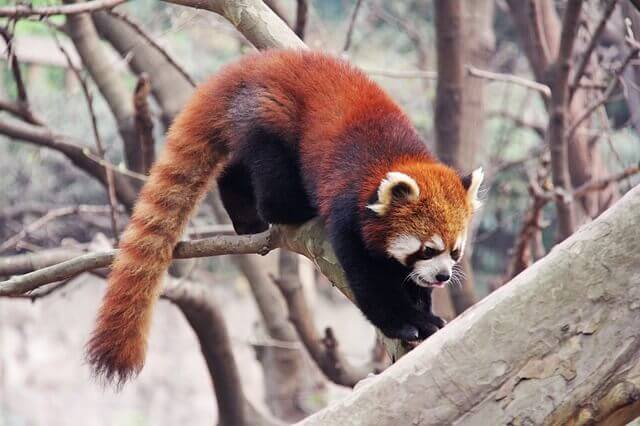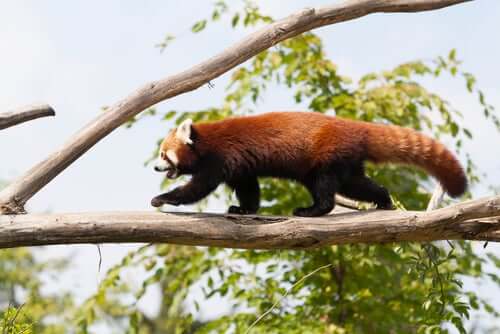The Red Panda: Behavior and Habitat

The red panda lives in the mountains of Nepal, Myanmar, and central China. Along with the panda, it is one of the most critically endangered species on the planet.
Despite its name and appearance (it looks kind of like a raccoon), the red panda is a unique species. It doesn’t belong to either of the other two we just mentioned. It’s in the Ailurus genus and the Ailuridae family.
Characteristics of the red panda
This species is usually about the size of a cat. At least, if you don’t count its tail, which can add up to 18 inches to its total length. They tend to weigh between 6.6 and 13.2 pounds.

The color of their fur is a chestnut red, except for their stomach and legs, which are black. Their tails have white and red stripes. Their ears, cheeks, snout, and the spots around their eyes are almost always white. That’s what makes them look so much like raccoons.
These mammals have a life expectancy of about 14 years in captivity. They’re in conservation programs in many zoos all over the world right now. This is mostly because of the destruction of their habitat. Along with illegal hunting, that destruction has caused them to become critically endangered.
Where do they live and what do they eat?
Their natural habitat is the bamboo forests in the Himalaya Mountains, anywhere from 5,000-15,000 feet above sea level. Agriculture, shepherding, and tree cutting are taking down the forests around them, though, which means they’re losing their habitat. That’s also a problem for their name-cousin: the panda.
Red pandas absolutely love bamboo. It’s a major part of their diet. Although they’re part of a carnivorous order of animals, they prefer a vegetarian diet. They mostly eat fruit, roots, sprouts, lichen, and bamboo leaves. But they can also capture insects, worms, and even small vertebrates.
Want to know a fun fact about them? They’ve developed a taste for sweets. The Monell Chemical Senses Center found this out when they were studying sweet receptor genes in various mammal species. The red panda seems to love the taste of sweeteners like sucralose, neotame, and aspartame.

Behavior
They’re a tree-climbing species. In fact, the bone on their wrists is so big it looks like a thumb. That helps them grab onto trees, and they’re extremely agile as they go from one tree to another.
They use trees for everything from sleeping, nest-building, and getting away from predators. The snow leopard is one of their main natural predators.

Solitary creatures
Red pandas are shy and nocturnal. They’re also solitary, except during the mating season. During that part of the year, males will start to make short, single-syllable noises, like a “wa.”
The red panda marks its territory through urine, the way dogs do. Their urine has a strong, musky smell that will let other animals know it’s there.
Female pregnancies last about 115 days. They can have anywhere between 1 and 4 cubs at a time, though generally they only have 2. They’re born blind, but with their hair already. They build nests in the trees to stay safe from potential predators.

The mothers take charge caring for and feeding the cubs, which stay in the nest for around 90 days. Male red pandas don’t show much interest in their offspring.
Want one last fun fact? This species also has the nickname fire fox, which has obviously created some confusion with the web browser of the same name. In fact, in Chinese, they have the same word for the red fox as the red panda. But the Firefox logo is based on the actual fox, not our beloved red panda.
We can only hope that by spreading awareness of this animal and the danger it’s facing, maybe we can do something to try to stop it from going extinct. Share this article far and wide!
All cited sources were thoroughly reviewed by our team to ensure their quality, reliability, currency, and validity. The bibliography of this article was considered reliable and of academic or scientific accuracy.
- National Geographic. Oso Panda Rojo.
- Analyses of Sweet Receptor Gene ( Tas1r2 ) and Preference for Sweet Stimuli in Species of Carnivora. Journal of Heredity, Volume 100, Issue suppl_1, July-August 2009, Pages S90–S100.
- Zoo de Barcelona. Oso Panda Rojo.